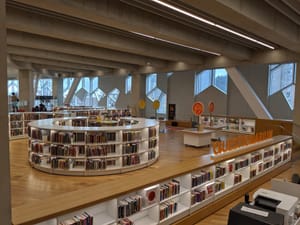One can read the phrase Integrated Library System (ILS) in two ways: as a system for the integrated library, or as an integrated system for the library. Although the latter is what was probably meant by the term, neither is an accurate description of what the ILS has become. In fact, it is a misleading term whose continued use is bemusing. It is clear that the ILS manages a progressively smaller part of the library activity. There has been a real shift in emphasis towards e-resource management (see the metasearch/resolver/ERM/knowledgebase suite of tools), and in some cases towards digital asset management. Libraries now manage a patchwork of systems which do not always play well together.
Think about the systems that support current library processes, and some possible directions. Items marked with ILS are typically a part of the ILS offering; those marked NILS are usually not.
Acquisitions (ILS). Libraries are part of larger organizations which ‘acquire’ a variety of materials and services, and have built enterprise systems to support this. It is likely that in many settings libraries will make more use of the generic institutional systems in the future.
Catalog (ILS). The local library catalog — let’s not use the user-unfriendly and jargonish ‘OPAC’ — is not a central part of most users’ information behavior. Users need to be able to discover items of potential interest to them and locate them in the library. The catalog does not do a great job with the former: it does not make its data work very hard. As it covers a part only of a user’s information needs, and a part only of the library collection, it may exert a progressively weaker gravitational pull on the user. More about this below.
Cataloging (ILS). Libraries have various cataloging workflows. They may acquire records from various resources, roll their own, participate in a shared cataloging environment. However, libraries are also creating metadata for other resources which may be poorly supported in their cataloging environment. They may have two workflows (their local system and a cataloging system such as Connexion from OCLC).
Circulation (ILS). This appears to be core function of the (current) ILS and it is where such systems started. However, even here there is an interesting trajectory in some environments towards group wide circuation systems. See Ohiolink for example, where the line between inter library loan and circulation becomes blurred.
Metasearch/portal (NILS). Much could be said about this intractably difficult challenge! (see here for a short and here for a long discussion of metasearch/portal activity). Some libraries are looking at wrapping a metasearch product around their various database offerings, including, in some cases, the catalog. Some libraries are putting a lot of effort into metasearch activity: it is useful, but metasearch will always be a partly broken service given the diversity of the target resource.
Resolver (NILS) The resolver is emerging as a critical part of library systems infrastructure, with the OpenURL binding resources together in various ways. The resolver moves the user from a discovered item to an instance of the item. We are likely to see OpenURLs used to tie together more systems in the future. See for example the current Google Scholar discussions, where a user might discover an item through Google and then be passed through to a resolver to locate local instances. This has been discussed in relation to articles; it could also happen with books, where the resolver talks to the catalog.
ERM/knowledgebase (NILS) A resolver or metasearch engine requires ‘intelligence’ about available collections. What is available? How do I connect to it? Under what terms and to whom is it available? Again, new services are emerging to help with this area, which may need to talk to acquistions systems and catalog.
Portable bibliography (NILS). Citation managers (Endnote, RefWorks, …) and reading lists are becoming more important. This light-weight bibliographic apparatus, a metadata bus if you like, provides interesting integration opportunities.
Digital asset management (NILS). Libraries are managing digitized local collections – maybe images from their special collections, historic newspapers, and so on. At the same time, many are looking at the systems infrastructure required to support institutional repository type services, where they provide management and disclosure services for research or learning materials produced within their institution.
Important other things Libraries may manage e-reserve systems, ILL systems, virtual reference systems, and so on. Various approaches to identity management may be in place.
So, there is a fragmented systems base, and service demands on some traditional service components are morphing as circumstances change. Here are some comments on this environment.
Thinking about collections
Reductively one can think about four collecting areas which are managed in different ‘boxes’:
- The Bought collection. Print books and journals, CDs, DVDs, and so on. This has been the core of the library collection and it is around this that the ILS was built. These materials are catalogued and are ‘circulated’ by the library.
- The licensed collection. A&I services, e-journals, and so on. These are now a major focus of investment and attention, and new systems components (metasearch/resolver/erm/knowledgebase) are being put in place to manage this. This area presents new metadata challenges in the form of data describing resources, the services through which they are made available, and the terms under which they are available.
- The local digitized collection
- The managed institutional research and learning output. This is the institutional repository and learning object repository space.
Libraries are digitizing their rare or unique materials, releasing their research and learning potential in new contexts. This activity is in the cottage industry stage. Metadata creation may be expensive. Digital asset management solutions are not quite routine yet.
The balance of investment between these collection areas is different in different libraries; but more interestingly it is probably changing within individual libraries. It is interesting to think what the relative balance between them will be in, say, ten years time, and what implications that has for systems support.
Thinking about services
One downside of this fragmented systems and collections environment is that it becomes more difficult to build services out on top of the collections. Too much effort is going into maintaining and integrating a fragmented systems infrastructure.
This becomes more of an issue as the pressure on the library to be seen to be ‘making a difference’ grows. Increasingly, the library needs to bring its services to the user within their work- or learn-flow, and be seen to be adding value to the collection of resources.
Thinking about directions
Here are some thoughts:
- The systems environment needs to become simpler. We will see more hosted solutions, better integration options in a ‘web services’ environment, and some consolidation of supply.
- For ILS vendors there seems to be an interesting shift away from their historic core towards e-resource management, and in some cases towards digital asset management.
- We will see less focus on the integration of library resources with each other as an end in itself, and more on the integration of library resources with user environments (personal, learning management system, etc).
- Following on from this, data and services need to be made available in ways which better facilitate their recombination in different user contexts. This touches on what I have called intrastructure, the applications tissue that allows us to more easily stitch together systems and services. RSS feeds, URL-based web services, bookmarklets, data import and export: these are all boundary crossing services which enable better stitching.
- I think that we are entering a period where opportunities to centralize services and data will be looked at more seriously again, as a way of reducing cost and complexity, and of releasing resources to focus on user experience.



